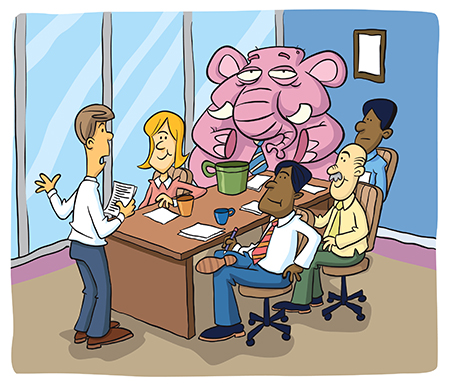3.1 What does conflict look like?

Conflict may result from poor communication, but it is much more likely to arise when people are stressed, which can lead to tensions in the organisation. However, before you can begin to deal with conflict, you need to be able to recognise that it exists.
In many cases, the signs of conflict will be highly visible – there may be arguments, ‘sniping’, rows, raised tempers and emotions, possibly even formal disputes and grievances. Such conflicts are easy to spot, but many conflicts are much less visible, particularly as the ethos of many voluntary organisations – with the sector’s strong commitment to caring – can lead to conflict being suppressed.
Like an iceberg, the conflicts lie mainly submerged below the surface of everyday life in the organisation. However, as with icebergs, there is usually something visible above the surface if you look carefully.
Some signs of potential hidden conflict include:
- a coolness or rigid formality in relations between the individuals or groups involved
- difficult or uncomfortable silences at meetings
- issues that seem to keep coming back onto meeting agendas time after time but never seem to be resolved
- an unwillingness to communicate between individuals or groups
- one individual or group ‘putting down’ another
- the withdrawal of parties from discussions and the avoidance of certain issues
- constant referral to formal rules and procedures.
The list of symptoms looks deceptively simple, and what you may actually experience could be some partial showing of some symptoms, or a combination of the above. For example, the desire in an organisation ‘not to wash our dirty linen in public’ may give rise to a partial exhibition of a selection of the symptoms described above in terms of communication.
Similarly, other signs listed above may be all that shows on the surface of what might be termed the ‘open secret’, something that ‘everyone’ knows is a source of enormous friction, but which no one seems capable of dealing with.
The actual problem itself is widely talked about in private, but in its true form never really surfaces. Instead, there may be a rigid formality in relations, difficult silences in meetings, withdrawal and greater use of formal rules and procedures.
Likewise, one of the classic symptoms of inter-departmental rivalry in larger organisations is a rigid correctness in the relationships. The metaphor ‘the elephant in the room’ is applicable to these situations (Figure 4).

Activity 3 Your experiences of conflict
Have you experienced conflict yourself or witnessed it with colleagues? Write some notes on the following questions:
- What were the signs of conflict?
- What do you think caused the conflict?
Comment
Perhaps you experienced or witnessed arguments or ‘frosty’ interactions. You might have identified several reasons for the conflict – perhaps people under stress with deadlines.
You will find out more about the causes of friction in the next section.
